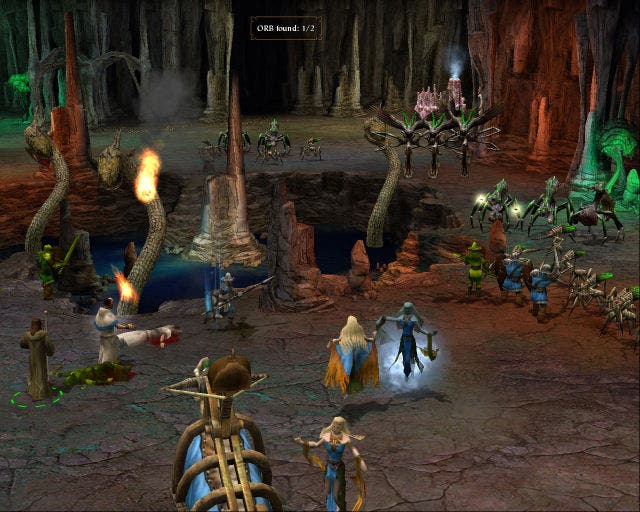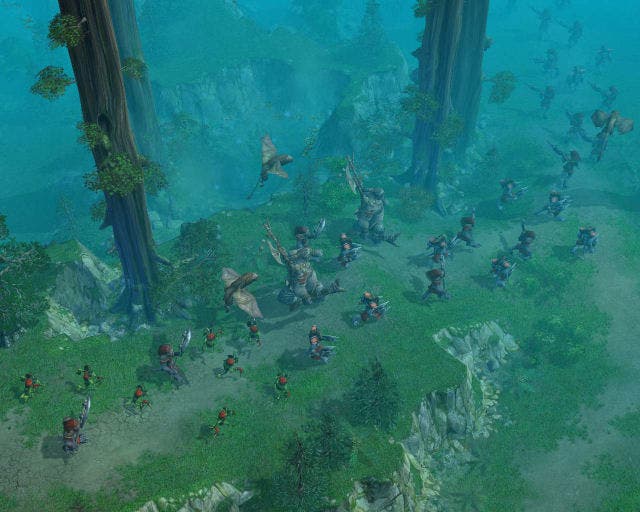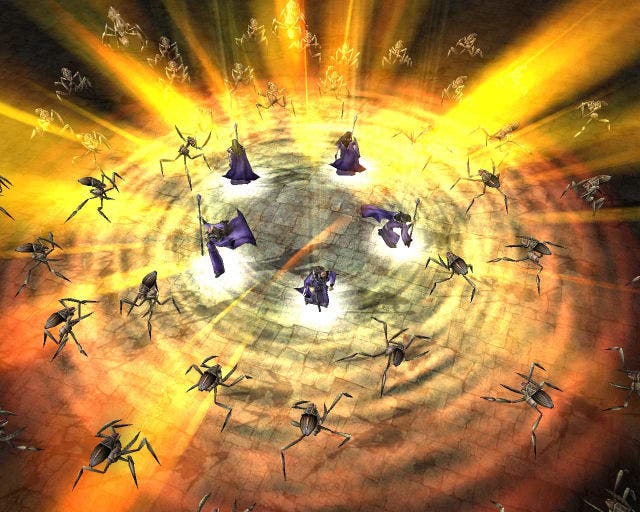Armies of Exigo
Not as crafty as it thinks.
Stop us if you've heard this one before. In a fantasy world made up largely of quaint little villages full of people who don't object to being dragged from their farms and forced to mine gold or hack down the local forests all day long, the Men and the Elves have an alliance which holds back the beast hordes - ogres, trolls, that sort of thing. The two forces rush headlong into an almighty barney, but it turns out that the real enemy is set to emerge from the shadows, with an evil force from beyond the stars seeking to take over the world, albeit somewhat handicapped by the peculiar refusal to build anything on ground that isn't covered in purple muck - presumably because it would clash terribly with the curtains, or something.
See, you have heard it before. We thought you might have. If you're looking confused right now, we can only assume that you haven't played Blizzard's Warcraft III - a seminal excursion into the real-time strategy genre which followed pretty much precisely the plotline we just described, albeit with quite a wonderful twist. The problem is, we weren't describing Warcraft III a moment ago; we were describing Armies of Exigo, a game which wants so desperately to be Warcraft III that it actually gets quite embarrassing at times, like an excessively self-delusional Elvis impersonator who insists that he really is the King, despite the fact that he's actually a 47 year-old bricklayer from Bedford.
Sincerest form of flattery?

Blizzard, of course, is quite used to people stealing ideas from its best-selling series of strategy games, but we can't remember ever seeing anyone so brazenly lift wholesale from another strategy title before now. Like many other RTS games, Armies of Exigo copies the basics of the Warcraft formula - tireless peasants mine for gold and gems, chop down trees, build buildings to advance through the tech tree and construct farms to allow you to create a larger army, while a fairly predictable range of fantasy units are constructed and run off to do battle or complete a set of objectives. There are three sides to the conflict, as mentioned - Empire (humans and elves and so on), Beast (ogres and what have you), and Fallen (evil alien things that just love the colour purple). The latter race is essentially directly ripped off from StarCraft's Zerg (and not dissimilar to Warcraft III's Scourge), as you might imagine; the former two aren't directly copied from anywhere, as such, but knights with swords, elves with bow and arrows, and ogres with great big clubs don't exactly tax the boundaries of creative fantasy.
What's striking about Armies of Exigo is that not only does it take these basics of game design and play from Warcraft, it also goes one step further and lifts the premise of the plot, the presentation of the game, and even the layout of the HUD directly from Blizzard's opus. The game makes no bones about what it's attempting to do - it's a clone of Warcraft III, presented with a nicer graphics engine (albeit arguably missing the colourful charm of Blizzard's art style) and great production values. Unfortunately the other striking thing about the game is that even with its shameless lifting of basic design elements from Warcraft, and the benefit of a couple of years of advancement in graphics technology, it still falls a long way short of the quality of the title it attempts to ape.
Missing Links

To be honest, we find that baffling. Warcraft III is a sublime game, and much of its magic lies in the superb production values and fine balancing which underlie it, but many of the features which make it so supremely playable aren't exactly difficult to fathom - or to copy. However, the team at Black Hole Entertainment seem to have chosen to copy a peculiar sub-set of the features from RTS games of the recent past; so, for example, we have hero-type units, but they don't have any of the clever levelling up features which were assigned to them in Warcraft III. You can pick up items on the battlefield, but you can't equip them to characters and they're exceptionally limited in use, and seem to have been added as an afterthought.
Most frustratingly, you can select large numbers of units at once - thanks to a "supergroup" system that lets you stick several groups together into one battle unit - but you lack the basic ability to tell units to move around in anything other than the most basic, computer-assigned formation, or not to run after every enemy in sight, thus making the stealthy approach to any situation utterly pointless. That can be intensely frustrating in battle, especially when you're defending a base and your troops keep running off into the woods to chase a minor enemy unit, leaving a huge hole in your front line. Most RTS games overcame troop management tedium like this years ago.
Going Down?

The one particularly interesting feature which has been added to the mix by Armies of Exigo is the use of a split-level map, with action taking place both on the surface and in a network of caverns and passages underground. You can launch attacks from the underground, or get magical-type characters to cast spells underneath (or above) an enemy base which will have an effect on the other level of the map; there are even special traps such as the ability to spread poison gas underground which seeps up to the surface and can damage enemies there. It's not a bad idea at all, and in places the game makes good use of the two-level approach. But ultimately it doesn't add a great deal to the gameplay and the need to flick between two maps while playing can feel very clunky indeed, especially when coupled with our other gripes with the controls.
In terms of innovation, though, that's pretty much your lot. Armies of Exigo really is the attack of the clone; everything about the game has been half-inched from some other popular mainstream RTS of the past few years, with Blizzard being by far the most common target for copying, and even the most casual PC RTS fan will recognise this game for a hodgepodge of decent bits lifted from other titles, but without the same level of solid gameplay or unit balancing that made those other games worth playing in the first place.
Glitch in the Matrix

In a lot of ways it’s a real shame that Black Hole Entertainment's first game gives us such déjà vu, because the team behind it is clearly talented. The graphics in the game are fantastic, and even if they're hardly the most original thing we've seen, the models and animations are nicely done. The rendered videos deserve a special mention - they're beautifully animated, and do withstand comparison to Blizzard's beautiful rendered scenes in Warcraft III, which is really saying something. Overall, the production values on the game are excellent - a few bugs here and there, especially with the sound, but there's a nice engine, good artwork and a well conceived interface on show here.
The letdown is in the design and script, both of which are bodged attempts to copy things that the creators thought were pretty good elsewhere. The gameplay is a castrated version of Warcraft III - you can see the hallmarks of a fine specimen, but the testosterone is all long gone - while the script is cringeworthy in places, reminiscent of the very worst desperate Lord of the Rings wannabes in fantasy fiction writing. As a game, it's a comprehensive package - good looking, fully featured and well polished - but it completely lacks any soul, or indeed any compelling reason to play it.
Despite this, it's hard to actively dislike Armies of Exigo. It's a well-made game from many perspectives, which would have seemed fantastic if we'd played it three or four years ago. Now, however, it suffers massively in the shadow of those games which it attempts to mimic - by inviting such direct comparisons with the giants of the genre in the first place, and then by failing to measure up to their standards. Regardless, we await the next game from Black Hole with interest - there's undoubtedly talent at work here, and with the benefit of some vision on the design front, the team behind this sadly average title could really be a force to be reckoned with in the RTS genre.

